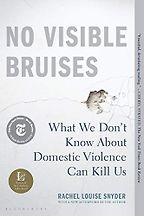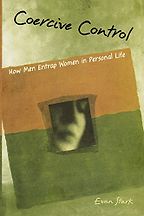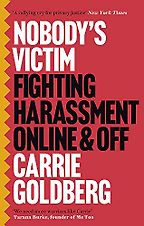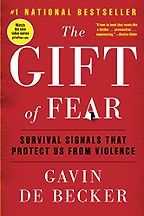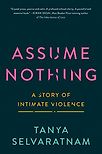Domestic violence, and books about it, is our topic. Although domestic violence – also known as intimate partner violence – rarely makes the news or is treated as a serious public health problem, the World Health Organization calls it an epidemic. How do experts define intimate partner violence?
Intimate partner violence takes many forms. It’s physical violence but also emotional abuse, digital abuse, legal abuse, and verbal abuse. According to the Centers for Disease Control, one in four women and one in 10 men will experience some form of intimate partner violence in their lifetime. And those forms include stalking and harassment.
In Assume Nothing, you share your lived experience with intimate partner violence.
At the time I met Eric Schneiderman, in 2016 at the Democratic National Convention, he was the Attorney General of New York State. It felt too good to be true that a powerful politician was paying attention to me and that we had so many overlapping interests. We had both gone to Harvard, studied Chinese and had an interest in spirituality and meditation. People worshiped him as a progressive paragon and a feminist hero. As the top law enforcement officer of New York State, he was known for introducing legislation and taking actions that protected women against violence, that protected reproductive freedom and that protected vulnerable communities, including the LGBTQ+ community.
Darkness seeped in as our relationship progressed. When the relationship became sexual, the violence entered. When he first slapped me across the face, during sex, it took me by surprise. Over time, the slaps got harder and were accompanied by demands that are humiliating to recall, but that I also feel are important to relay in the book because I have discovered that these experiences are not specific to me. In addition to the physical violence, the verbal abuse started. I wasn’t prepared for the grooming and gaslighting and manipulation.
Get the weekly Five Books newsletter
In the book, I take the reader through the stages that I went through as I become entangled in an abusive relationship. When we first started a relationship, he was adoring and supportive and complimentary. He praised my work. He even praised the scar that I have down my torso, from cancer surgery. Months later, he urged me to get plastic surgery to remove the scar and a boob job. Abusers are skilled at tapping into the victim’s weakness and customizing their abuse to each victim. So with another girlfriend, Eric would tell her to get botox and criticized her thick ankles. He controlled what I ate and what I wore and how I did my hair. Those are examples of coercive control.
Kirkus Reviews called Assume Nothing “a candid, often frightening exploration of the diabolically schizophrenic ways that the patriarchy conspires to disempower women.” What is the connection between intimate partner abuse and power?
The cycle of violence that we’re conditioned to normalize from the time we are born is entwined with the patriarchy. Patriarchy involves a power over mindset. It emphasizes having power over other people and places the man’s needs over the woman’s. True power allows others to be their best self and rise together. In addition to giving readers resources for how to spot, stop and prevent intimate partner violence, my book is also a call to action to chip away at the patriarchy that enables the violence.
You’ve selected five books about domestic violence. Let’s begin with No Visible Bruises, which won the Hillman Prize and made countless lists for the top books of 2019.
Rachel Louise Snyder has done groundbreaking work on this difficult subject and opened up a discourse about how domestic violence involves invisible harms. The bar at which domestic violence becomes a crime often involves visible bodily harm, but victims are broken down in many ways that are not visible. Abuse can be verbal, emotional and digital and legal.
Snyder illuminates the failure of government to address this pandemic. There’s a statistic in the book, from the American Journal of Preventative Medicine, estimating that in the United States, the lifetime economic costs associated with intimate partner violence – including lost productivity from paid work, criminal justice and other costs – is $3.6 trillion. The United States spends 25 times more on studying cancer or heart disease than it does on the prevention of intimate partner violence, despite the enormous cost to our communities.
What made this book so impactful for me is how Snyder stacked it with data and statistics about the prevalence of this problem.
Domestic violence is the number one reason for calls to 911, but it’s also one of the most underreported crimes.
You write about the fact that your parents are from Sri Lanka and that your father abused your mother. Do you have a sense of the scale of the problem in Sri Lanka and how often it is true that girls who grow up witnessing abuse become embroiled in abusive relationships as adults?
There is so much shame surrounding this issue in the South Asian community. It would be very difficult to get accurate statistics. And it’s very hard to talk about within the community. I know in my mother’s case, one of the reasons it was so difficult for her to get out is that she didn’t have enough resources, and there was so much stigma surrounding divorce amongst her generation.
Next, Not That Bad: Dispatches from Rape Culture by feminist theorist, essayist, novelist and activist Roxane Gay.
In the introduction to this collection of essays on rape culture, Roxanne recalls being gang raped when she was 12 years old and how she has learned to live with this trauma. She writes, “Those boys killed the girl I was, but they didn’t kill all of me.” She writes about what it is like to live in a culture where it often seems like it is a question of when – not if – a woman will encounter sexual violence.
Roxane Gay really brings to the fore how rape culture inundates us. As Lynn Higgins and Brenda Silver write in Rape and Representation, “rape and sexual violence have been so ingrained and so rationalized through their representations as to appear ‘natural’ and inevitable.” What are they getting at?
Not That Bad collects stories from multiple writers who have experienced sexual violence and highlights how prevalent it is and how important it is for us to share our stories so that we continue to take away the shame. The stigma comes from secrecy. Through storytelling, we realize that we are one of many, that we’re not alone, that we’re not crazy, and that this problem needs to be addressed.
“She writes about what is it like to live in a culture where it often seems like it is a question of when – not if – a woman will encounter sexual violence”
Part of addressing the problem is compelling media and social media to have more accountability for normalizing and facilitating sexual violence. When I heard from friends and strangers that they had also experienced slapping, spitting and choking, I thought these abusers are all steeped in media that glorifies violence against women. We need more female and feminist directors of porn that celebrate mutual pleasure and includes consent.
Coercive Control by Evan Stark is your next book recommendation on the subject of domestic violence.
Evan Stark writes, “To make contemporary women their personal property, the modern man must effectively stand against the tide of history, degrading women into a position of subservience that the progress of civilization has made obsolete.” Coercive Control is about a man getting his power fix through abuse and it’s about how intimate partner violence preserves patriarchy. My situation, with Eric, manifested this. He subjected me to his master-slave fantasies, which were flat-out racist.
Evan Stark founded one of America’s first battered women’s shelters in the 1970s. Since the first battered women’s shelters were started, they have spread all over the world. Countries that fail to recognize spousal abuse as a crime are now the exception, not the rule. In the US, shelters in 3,000 communities serve over 3 million women and children each year. Yet the prevalence of violence against women has not changed significantly. Batterer intervention programs do more harm than good, the battered women’s defense has saved some but not all victims from being imprisoned for self-defense, and the chance of a batterer going to jail remains vanishingly small. So, although so much has changed, intimate partner violence remains stubbornly and lethally prevalent. Why?
There needs to be a whole ecosystem change, that begins with education from a young age. Millions of women and men experience intimate partner violence before they turn 18. Parents need to talk to their children. We must make peace and kindness more exciting than violence and bullying. Female empowerment and anti-violence programs can play a role. On a legislative level, there need to be more repercussions for abusers. Laws need to be strengthened. I believe in restorative justice, when victims are willing. Law enforcement need to go through intimate violence training to have a more victim-centered approach. There also need to be increased government resources for organizations that provide shelter, legal services and mental health counseling for victims, survivors and their loved ones.
Your next book, Nobody’s Victim – by victims’ rights attorney Carrie Goldberg – is part memoir, part battle cry.
Carrie Goldberg is a warrior who was herself a victim of sexual violence. The stories she recounts of dates that turned violent in her own life are horrific. After one first date, she woke up with a swastika stitched into her bottom.
Five Books interviews are expensive to produce. If you're enjoying this interview, please support us by donating a small amount.
The book is about helping people deal with abusive partners, especially those who are victimized through digital means. It also calls out the technology platforms that proliferate violent and vitriolic content with total impunity. These tech companies are shielded from responsibility by Section 230 of the Communications Decency Act, which absolves social media platforms of responsibility for the content they disseminate. It’s either naive or nefarious that social media platforms, especially Facebook and Twitter, act as if they’re innocent. It is cognitive science 101 that the mind is malleable and repetitive messaging can twist minds. These social media platforms bear some responsibility for brainwashing. I think that there needs to be a class action lawsuit against them.
Since Nobody’s Victim centers on crimes that take place in virtual space, I wanted to ask you about how the word ‘violence’ is being redefined. Lately, in the United States, people use the word to describe activities that involve no physical force. Frequently, the word violence is used when describing disfavored speech in a political or academic setting. Although I recognize that nonphysical acts can have extremely harmful and even physical consequences, I am concerned that using the word violence to describe speech or virtual activities may undercut efforts to stem the lethal epidemic of domestic abuse. What do you think?
There is a need for better education and public awareness about different forms of violence. This is something that Roxane Gay talks about in Not That Bad. She discounted what she experienced at ‘not that bad’ because others deal with more. I discounted my situation because I thought: what I’m experiencing is nowhere near as bad as what my mother experienced. She got black eyes while I just had a stinging cheek. I believe that the punishments should fit the harm. But there are not enough repercussions for the forms of intimate partner violence that don’t involve bodily bruises.
Finally, please tell me about The Gift of Fear by security specialist Gavin de Becker. It’s the fifth and final book on our domestic violence reading list.
De Becker witnessed horrific domestic violence as he was growing up. He felt guilty that he couldn’t protect his mother. As an adult, he made it his life’s work to protect others. This book is his effort to arm people with information to strengthen their physical and digital defenses.
This book taught me about the difference between good fear and bad fear. Bad fear prevents us from living our best life. Good fear heightens our sensitivity to people, places and things that we should avoid. One might call it intuition. As de Becker explains, “when it comes to danger, intuition is always right in at least two important ways. One, it is always in response to something. Two, it always has your best interest at heart.”
De Becker designed a threat assessment system which is now used by law enforcement to predict violence in the home and prevent it. I am amazed by how little attention is given to studying and preventing domestic abuse. Gender typically receives far less attention than other demographic characteristics in research into homicide, according to the criminologist Emma Fridel. While this makes sense, since nearly three-quarters of homicides involve men killing men, Fridel explains that as a result, patterns in female victimization are overlooked. How can we change this?
There need to be more governmental resources focused on gender-based violence. We need to look at the ways in which gender justice intersects with racial justice, with climate justice, with immigration justice. There is a lot of work to do, but it’s doable work. We just need resources to identify solutions that are more effective. To get those resources we need awareness. That is one of the reasons why I wrote Assume Nothing.
Five Books aims to keep its book recommendations and interviews up to date. If you are the interviewee and would like to update your choice of books (or even just what you say about them) please email us at [email protected]
